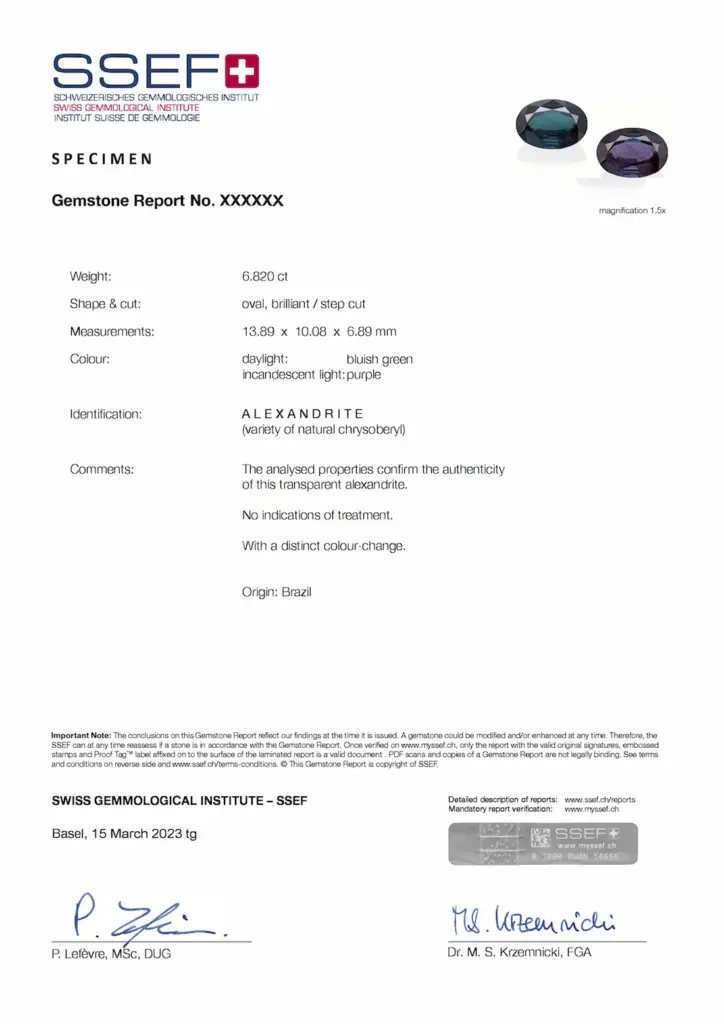Alexandrite
Alexandrite is a variety of chrysoberyl with a definite colour change due to the presence of chromium traces. The different colours appear due to the light source under which the stone is observed. The effect depends on the amount and distribution of colour-giving trace elements. The two colours are usually blue-green in daylight and purplish-red in incandenscent light.

Report No & Photo
The SSEF report number is the number given to the alexandrite when it is submitted for testing, and is a unique number. If an item is resubmitted later for a ‚recheck‘ after re-cutting or for a report update then the item obtains a new report number.
The photo of an alexandrite in the two lighting conditions (daylight and incandescent light) depicts the gem at the time of testing. The photo on an SSEF report is for representational purposes and does not necessarily represent actual colour, clarity or size. For size comparison purposes, approx. magnification used is provided under the photo on the report.
Weight
Weight of an alexandrite in carats, measured and stated with 3 digits. In the case of mounted jewellery, total weight corresponds to total weight of jewellery item(s) and is stated in grams.
Shape & Cut
The shape and cut describe the outlining shape and cutting style of an examined gemstone. For jewellery items with several stones, a range of shapes and cuts may be stated, if these vary.
Measurements
The measurements are given at 2 decimal places. They generally represent length x width x height of a gemstone. For series of gemstones or gemstones in jewellery, a range of measurements may be stated on the report.
Colour
If the colour change is deemed sufficient (it must be obvious with the light source and both observable from approx. 20 cm distance), then for an alexandrite the colour on a report is given both under daylight and incandescent light. These two colours correspond to the colour-change range. The degree of colour change is detailed in the comments of the report. SSEF differentiates between moderate, strong and distinct colour-change for alexandrite. A weak colour change is not mentioned on an SSEF report, and such chrysoberyls are not considered to be alexandrites.
Identification
The identification section of an SSEF report can include the variety name and the mineralogical group name of a gemstone. As such, for alexandrites:
- Alexandrite (natural variety of chrysoberyl)
A chrysoberyl with insufficient colour-change or not matching alexandrite trace-element chemistry would be identified as chrysoberyl in the identification section of an SSEF report.
A synthetic alexandrite would be clearly identified and labeled on a report in the identification section.
Treatment
Treatment detected in an alexandrite (including fissure-filling) would be written in the comments section of an SSEF report. If no treatment has been identified ‘no indications of treatment’ would be written on the report.
Origin
Origin determination is an expert opinion. At SSEF origin determination relies on the analysis of microscopic features, trace element concentrations, and spectroscopic data of a coloured gemstone. The measured data pertaining to a specific client stone is then compared with our extensive reference collection and database of coloured gemstones of known origin, and scientific gemmological literature.
Report date & verification
The date corresponds to the date on which gemmological testing of the item was concluded. SSEF reports can be verified on www.myssef.ch